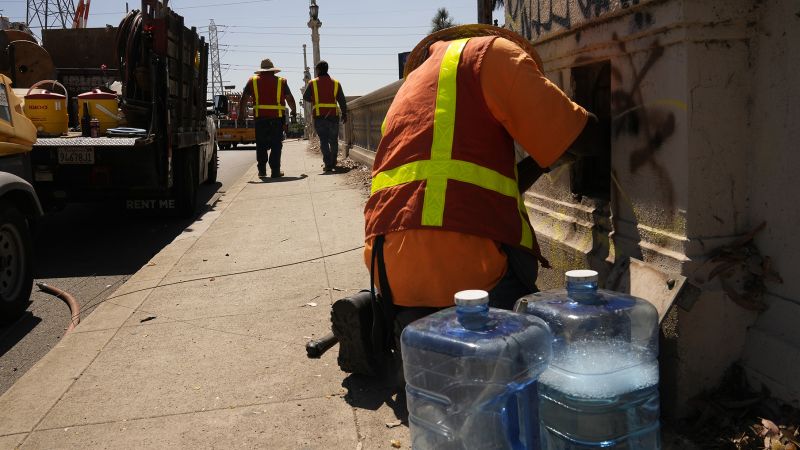Record Heat Wave in Phoenix: Impact on Businesses and Economy
As temperatures in Phoenix soar to a scorching 119 degrees, the extreme heat is taking a toll on businesses and the economy. Lyn Thomas, owner of Zydeco’s Louisiana Kitchen Food Truck, knows firsthand the challenges of operating in such oppressive conditions. With temperatures exceeding 110 degrees for 23 consecutive days, it’s simply not feasible for her to rely on foot traffic. Instead, she has had to adapt and focus on building up her catering business.
The Unrelenting Heat
Describing the heat as “miserable,” Thomas explains that even at night, when the sun is down, the temperature remains in the triple digits. The relentless heatwave has not only affected Phoenix but also a large portion of the United States. This prolonged period of extreme heat is not only uncomfortable for millions of Americans but also comes with significant economic consequences.
The Economic Toll
While it’s difficult to quantify the exact economic impact of this weather event, recent studies suggest that extreme heat could cost the United States $100 billion annually in productivity loss alone. If left unchecked, it could even sap one-sixth of global economic activity by the year 2100. The economic cost of heat stress is becoming increasingly evident, as heatwaves can cause disruptions in business continuity, stress regional power grids, and drive up the cost of space cooling.
Expert Insights
Chris Lafakis, Moody’s Analytics’ director of economic research, emphasizes the economic cost of heat stress. He points out that heatwaves can lead to mortality, disrupt businesses, and strain power grids. These factors contribute to increased costs and reduced availability of space cooling, further impacting the economy.
The Urgency to Address the Issue
As the heatwave continues to grip Phoenix and other parts of the country, it becomes crucial to address the economic and societal implications of extreme heat. Taking proactive measures to mitigate the effects of heat stress can help protect businesses, preserve productivity, and ensure the well-being of individuals.
Conclusion
The record-breaking heatwave in Phoenix is not just a matter of discomfort; it has far-reaching consequences for businesses and the economy. From the challenges faced by food truck owners like Lyn Thomas to the potential trillion-dollar economic impact, the urgency to address the issue of extreme heat is clear. By understanding the economic costs and taking necessary precautions, we can work towards a more resilient and sustainable future.How Extreme Heat is Impacting Workers and the Economy
Extreme heat is not only uncomfortable, but it also has a significant impact on workers and the economy. According to Moody’s Analytics, chronic physical risk from heat stress could reduce worldwide GDP by up to 17.6% by 2100. This means that workers, especially those who work outdoors, are less productive.
The effects of heat on workers are numerous. Kathy Baughman McLeod, director of the Adrienne Arsht-Rockefeller Foundation Resilience Center, explains that heat can slow down thinking, impair concentration and hand-eye coordination, and cause fatigue and mistakes. In fact, a report by the Atlantic Council estimates that heat-related productivity losses could amount to $100 billion.
While sectors like agriculture and construction experience the steepest losses, no industry or business is immune. Even employees working in air-conditioned environments may face challenges at home, leading to disruptions in sleep and subsequent exhaustion and poor performance.
One of the concerning aspects is that the heat is accelerating faster than our perceptions of risk. This means that both workers and employers may not fully understand the dangers and risks associated with extreme heat.
To address this issue, the Arsht-Rockefeller center is working on building awareness of this “invisible, silent risk.” They are testing the naming of heat waves and creating a health-based warning system. However, despite efforts in some states like California, there are no national regulations in place to protect workers from extreme heat.
In places like Holtville, California, where temperatures can reach 115 degrees, farmers like Jack Vessey are no strangers to extreme heat. As a fourth-generation farmer in California’s Imperial County, Vessey understands that extreme heat is just a part of living in the desert.
While some may be accustomed to extreme heat, it is crucial to recognize the impact it has on workers and the economy. By understanding the risks and implementing necessary protections, we can ensure the well-being and productivity of workers in the face of rising temperatures.Discover how workers in different industries are adapting to extreme heat conditions and prioritizing safety. From agricultural workers in California to roofing contractors in Texas, these individuals are taking precautions to protect themselves and their animals. Learn about the challenges they face and the measures they take to stay safe in scorching temperatures. Find out why education and awareness are crucial in preventing heat-related illnesses and injuries. Explore the strategies employed by these workers to ensure their well-being and productivity. Don’t miss the insights shared by industry professionals who understand the importance of prioritizing safety in extreme weather conditions.Discover how the Phoenix Zoo and Arizona Wilderness Brewing are adapting to the scorching summer heat to protect their animals, patrons, and staff. From frozen treats for the animals to reduced hours and increased cooling systems, these organizations are going above and beyond to ensure everyone stays safe and comfortable. But with revenue losses and decreased sales, they may need to make even more adjustments in the future. Find out how these businesses are navigating the challenges of extreme heat and what it means for their long-term operations.Extreme heat is taking a toll on businesses, including Arizona Wilderness Brewing. The brewery is spending thousands of dollars on cooling equipment and maintenance to keep their beer cold during scorching summers. The heat is causing their coolers to break down, impacting their ability to keep up with demand. Additionally, the extreme weather has caused delays in the release of their popular watermelon Gose beer. The brewery works closely with farmers, who are also affected by the weather, leading to supply chain disruptions. This is just one example of how excessive heat is impacting businesses and the economy. According to an economist, the increasing severity of heat events will continue to drag down productivity and output. In fact, there may even be a dip in GDP due to the effects of extreme heat. This is a concerning trend that businesses and policymakers need to address.
Unveiling the Potential Economic Impact of Scorching Summer Temperatures
Introduction:
As global temperatures continue to rise, the world is experiencing scorching summer temperatures like never before. While the immediate consequences of extreme heat on human health and the environment are well-documented, the potential economic impact of these soaring temperatures remains a topic of concern. This article aims to shed light on the various ways in which scorching summer temperatures can affect economies worldwide.
1. Agricultural Sector:
One of the most vulnerable sectors to extreme heat is agriculture. Rising temperatures can lead to reduced crop yields, increased water demand, and a higher risk of pests and diseases. These factors can significantly impact food production, leading to potential food shortages and price hikes. Moreover, farmers may face financial losses due to damaged crops and increased costs associated with irrigation and pest control.
2. Energy Sector:
Scorching summer temperatures often result in increased energy consumption as people rely heavily on air conditioning and cooling systems. This surge in demand can strain power grids, leading to blackouts or brownouts. Energy providers may also face challenges in meeting the increased demand, potentially resulting in higher electricity prices. Additionally, the need for increased cooling can lead to higher energy consumption, further exacerbating greenhouse gas emissions and climate change.
3. Tourism and Hospitality Industry:
The tourism and hospitality industry heavily relies on favorable weather conditions to attract visitors. However, scorching summer temperatures can deter tourists, particularly in regions known for their pleasant climates. Popular tourist destinations may experience a decline in visitor numbers, resulting in reduced revenue for hotels, restaurants, and local businesses. Moreover, extreme heat can also impact outdoor activities, such as hiking or sightseeing, further affecting the tourism sector.
4. Health and Labor Productivity:
Extreme heat poses significant health risks, including heatstroke, dehydration, and respiratory problems. These health issues can lead to increased hospital admissions and healthcare costs. Moreover, high temperatures can reduce labor productivity, particularly in outdoor industries such as construction and agriculture. Workers may experience fatigue, decreased concentration, and an increased risk of accidents, ultimately impacting economic output.
5. Infrastructure and Maintenance:
Scorching summer temperatures can cause damage to infrastructure, including roads, railways, and buildings. Heatwaves can lead to the expansion and contraction of materials, resulting in cracks and structural weaknesses. Repairing and maintaining infrastructure in the face of extreme heat can be costly and time-consuming, diverting resources from other essential projects.
Conclusion:
The potential economic impact of scorching summer temperatures is a matter of great concern. From agriculture to tourism, energy consumption to health, various sectors face significant challenges due to rising temperatures. Governments, businesses, and individuals must recognize the urgency of addressing climate change and implementing measures to mitigate its effects. Investing in sustainable practices, developing climate-resilient infrastructure, and promoting energy efficiency are crucial steps towards minimizing the economic consequences of extreme heat. Only through collective action can we hope to safeguard our economies from the scorching summers that lie ahead.









